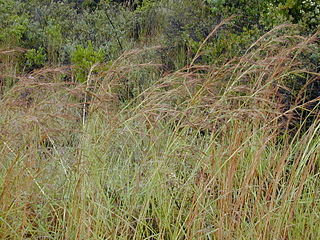
The International Union for Conservation of Nature (IUCN) Red List of Threatened Species, also known as the IUCN Red List or Red Data Book, founded in 1964, is the world's most comprehensive inventory of the global conservation status of biological species. It uses a set of precise criteria to evaluate the extinction risk of thousands of species and subspecies. These criteria are relevant to all species and all regions of the world. With its strong scientific base, the IUCN Red List is recognized as the most authoritative guide to the status of biological diversity. A series of Regional Red Lists are produced by countries or organizations, which assess the risk of extinction to species within a political management unit.

Hypochaeris radicata – also known as catsear, flatweed, cat's-ear, hairy cat's ear, or false dandelion – is a perennial, low-lying edible herb often found in lawns. The plant is native to Europe, but has also been introduced to the Americas, Japan, Australia, and New Zealand, where it can be an invasive weed. It is listed as a noxious weed in the northwestern U.S. state of Washington.

The Gomphrenoideae are a subfamily of the Amaranthaceae.

A least-concern species is a species that has been categorized by the International Union for Conservation of Nature (IUCN) as evaluated as not being a focus of species conservation because the specific species is still plentiful in the wild. They do not qualify as threatened, near threatened, or conservation dependent.

A species that is extinct in the wild (EW) is one that has been categorized by the International Union for Conservation of Nature as known only by living members kept in captivity or as a naturalized population outside its historic range due to massive habitat loss.
Rhizochaete is a plant pathogen infecting planes, beeches, pines, oaks and other trees.

Day's shrew is a species of mammal in the family Soricidae. It is endemic to India. Its natural habitat is subtropical or tropical dry forests. It is threatened by habitat loss.
Lithophila is a genus of plants in the family Amaranthaceae. Some species are endemic to Ecuador.
Alternanthera subscaposa, synonym Lithophila subscaposa, is a species of plant in the family Amaranthaceae. It is endemic to the Galápagos Islands.

Hyparrhenia is a genus of grasses. Many species are known commonly as thatching grass.

Octomeria lithophila is a species of orchid endemic to southeastern Brazil.

Phaonia pallida, the muscid fly or orange muscid fly, is a species of fly in the family Muscidae.
Low Redford Meadows is a Site of Special Scientific Interest in the Teesdale district of County Durham, England. It consists of two separate areas of meadows, situated in the floodplain and on the valley slopes of Bedburn Beck, 2 km upstream from the village of Bedburn. Like Frog Wood Bog SSSI, a short distance upstream, the meadows lie within the confines of Hamsterley Forest.

The World's 25 Most Endangered Primates is a list of highly endangered primate species selected and published by the International Union for Conservation of Nature (IUCN) Species Survival Commission (SSC) Primate Specialist Group (PSG), the International Primatological Society (IPS), Global Wildlife Conservation (GWC), and Bristol Zoological Society (BZS). The IUCN/SSC PSG worked with Conservation International (CI) to start the list in 2000, but in 2002, during the 19th Congress of the International Primatological Society, primatologists reviewed and debated the list, resulting in the 2002–2004 revision and the endorsement of the IPS. The publication was a joint project between the three conservation organizations until the 2012–2014 list when BZS was added as a publisher. The 2018–2020 list was the first time Conservation International was not among the publishers, replaced instead by GWC. The list has been revised every two years following the biannual Congress of the IPS. Starting with the 2004–2006 report, the title changed to "Primates in Peril: The World's 25 Most Endangered Primates". That same year, the list began to provide information about each species, including their conservation status and the threats they face in the wild. The species text is written in collaboration with experts from the field, with 60 people contributing to the 2006–2008 report and 85 people contributing to the 2008–2010 report. The 2004–2006 and 2006–2008 reports were published in the IUCN/SSC PSG journal Primate Conservation,, since then they have been published as independent publications.

Neoparrya lithophila, also known by the common names Bill's neoparrya and rock-loving aletes, is a species of flowering plant in the carrot family. It sometimes treated as the sole member of the monotypic genus Neoparrya, though other treatments place it in the genus Aletes.

Hymenopellis is a genus of fungi in the family Physalacriaceae. The genus was described by mycologist Ron Petersen in 2010. The type species is Hymenopellis radicata, originally described by British botanist Richard Relhan in 1780 as Agaricus radicatus.
Vasudeva Krishnamurthy (1921-2014), nicknamed Prof. V.K., was an Indian algologist. He established Krishnamurthy Institute of Algology at Chennai to promote the study of algology. Krishnamurthy, son of Sanskrit professor R. Vasudeva Sharma, was born on August 14, 1921 at Valavanur, Viluppuram district. He died in Tamil Nadu on May 9 2014.
Botanophila fonsecai, also known as Fonseca's seed fly, is a small fly endemic only to an approximately 100 m stretch of coastal dune system of north-eastern Scotland. The fly is named after British entomologist Evelyn d’Assis-Fonseca. It is classified as an endangered species by the IUCN Red List due to its small habitat range and constant threats to these limited environments. The fly is probably the rarest endemic insect species in the UK.
Epacris lithophila is a species of flowering plant in the heath family Ericaceae and is endemic to a small area of New South Wales. It is an erect shrub with few branches, lance-shaped to elliptic leaves and creamy-white, tube-shaped flowers.












